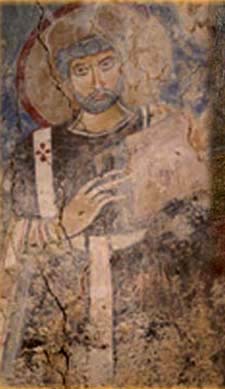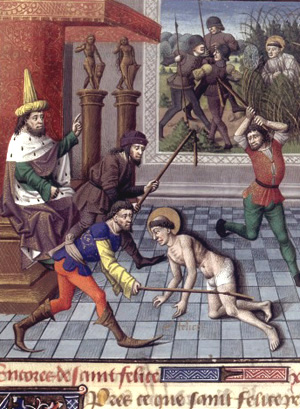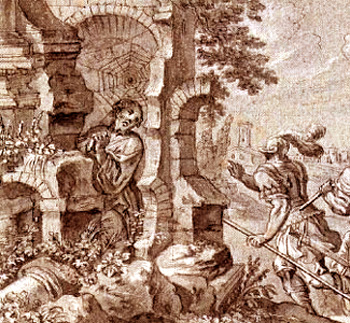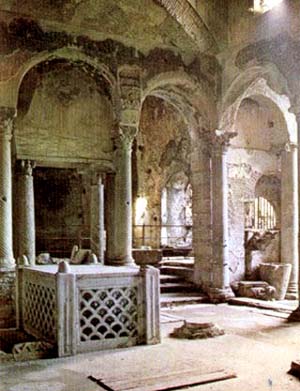 |
The Saint of the Day
St. Felix of Nola – January 14
Prof. Plinio Corrêa de Oliveira
Biographical selection:
An account tells us that one day the Bishop of Nola, Maximus, fell to the ground exhausted from hunger and cold fleeing from his persecutors [the persecution of Decius in the 3rd century]. Felix, warned by an Angel, came to help him. He squeezed a cluster of grapes he found miraculously on a bush into the Bishop’s mouth to give him some food. Then he carried the old man on his shoulders back home. When the Bishop died, Felix was elected to succeed him.
Note: According to several sources known today, St. Felix was chosen to be a Bishop, but would have declined the Bishopric, indicating another priest to take that dignity. In the case these sources are objective, this part of The Golden Legend would be historically imprecise, as the comments based on it.

St. Felix of Nola, mural on the walls of Chiesa di Santa Maria Assunta
|
One day when he was preaching and his persecutors were looking for him, Felix slipped through a narrow opening in the wall of a ruined house and hid there. In a trice, by God’s command, spiders spun a web across the space. The pursuers, seeing the web, thought that no one could have gone through the opening, and went on their way. Then Felix took refuge in another place and a widow brought him food for three months, but she never saw his face.
Finally peace was restored and he returned to his church, were he went to his final rest in the Lord. He was buried outside the city, in a place called Pincis.
Felix had a brother also called Felix. When the persecutors tried to make him worship the idols, he said to then: “You are the enemies of your gods; if you take me to them, I will blow upon them as my brother did, and they will be shattered.”
Some pagans came to seize Felix but were stricken with intolerable pain in their hands. They howled with the pain, and Felix said to them: “Say ‘Christ is God’ and the pain wll leave you.” They said the words and were cured.
A priest of the old gods came to him and said: “Sir, my god saw you coming and took flight. I asked him why he fled, and he answered: ‘I cannot bear this Felix’ holiness!’ Therefore, if my god fears you so much, how much more should I fear you!” Felix then instructed him and he was baptized.
From The Golden Legend by Blessed Jacobus of Voragine.
Comments of Prof. Plinio:
Actually we have here a series of small charming facts that would furnish matter for comment for several evenings. I will summarize them.
Naturally, one is not obliged to believe these small stories. A person overly concerned about whether these facts really happened does not understand the point of these legends. A legend is based on a truth that is disfigured or, perhaps transfigured, by the pious imagination of the people. The lives of the saints often lack pieces of information in some points, which nonetheless provide a few historical clues about what happened. The simple people who admire the saint then start to imagine what could have happened that would explain those unexplained points in harmony with the saint’s life. So, they form a hypothesis.

St. Felix is shown being flogged by his persecutors
|
This hypothesis is so beautiful that it spreads to others, who in turn repeat it over and over. It ends by being transmitted as a legend. It does not have historical precision, but often it transmits an important part of the spirit of the saint.
Something like this happened with the lives of many saints, giving birth to this true masterpiece that is The Golden Legend by Jacobus of Voragine. In addition to their historical interest – which should not be disregarded – these stories have an extraordinary moral value and a great literary beauty.
Take for example the life of St. Felix of Nola. Because of his dedication, he took on the burden of a desperate situation. Maximus Bishop of Nola, a city of Italy, is fleeing a persecution of the Roman soldiers and falls to the ground in hunger and cold. The life of this unfortunate man crosses paths with St. Felix’. St. Felix goes to him, feeds him, warms him, brings him back to his home and takes care of him, thus running the risk of being persecuted also. That is, for the love of Our Lord Jesus Christ and His Church, he took it upon himself to shelter the one who was being persecuted. This is the moral profile of St. Felix that we find depicted in The Golden Legend, which perfectly fits the moral profile of a saint.
How did the legend portray this episode? It paints St. Felix as being warned by an Angel that the Bishop needed his help. It is a beautiful scene. We can imagine St. Felix praying at his place and suddenly, a splendorous Angel appears to him, causing St. Felix to marvel. Instead of giving him a pleasant task, the Angel gives him a difficult one: “The Bishop of Nola is in need and you must go and risk your life to find and save this Bishop.” St. Felix accepts; he says “yes” to the Angel as Our Lady did to St. Gabriel.
Then he goes out, finds the half-dead man, and realizes he has no provisions to give the sick man to restore him. A cluster of grapes appears miraculously on a bush and St. Felix squeezes it to give the poor Bishop some food. The Bishop feels himself relieved not only by the juice of the grapes, but also by the tenderness and care of the man who came to assist him. The selection is not clear whether St. Maximus died soon afterward or later, but this is not what matters here. Someone could ask whether those grapes actually existed as a historical fact. I don’t know if they existed or not. Perhaps they are legend. But I think that even if they were only legend, they would be more beautiful for having been born from a Catholic piety that thirsted for the marvelous than if they had actually appeared miraculously on that bush.

A spider web conceals St. Felix from his Roman pursuers
|
Then St. Felix takes that old Bishop upon his shoulders – we can see that he was a strong man – and carries him as one who carries a great treasure. He brings the Bishop back to his home, lays him in his bed, and takes care of him.
Then – either shortly afterward or some time later – St. Maximus goes to Heaven. The people gather to mourn the dead Bishop, and choose St. Felix as his successor. Now he is no longer the one who assists the man who was persecuted. Rather, he inherits the cause of the persecution. He takes the cross of the other and carries it on his own shoulders, just as he had carried the man himself some time before. The first was persecuted because he was a Bishop; the second becomes a Bishop to be persecuted.
You can see that The Golden Legend is describing the high moral profile of St. Felix that corresponds to his actions. The essence of the legend must be true. The accidents of the Angel appearing and the miraculous grapes do not change the moral lesson the life of St. Felix gives us. It also has an extraordinary literary beauty.
Another very beautiful fact is the description of how St. Felix hid from his enemies. They were close on his tracks when he hid in the wall of a ruined house. He entered through a narrow opening and immediately afterward, a spider spun a web over the passage to mislead the persecutors. They saw the web and figured that no one could have passed through that opening for some days. So they went on, leaving the saint safe.

The tomb of St. Felix in the Basilica di San Felix in Cimitile, built in the 3rd century
|
A man protected from terrible persecutors by a spider is extremely charming and poetic. It is a very beautiful episode. Soldiers of the Roman legion, all armed, are searching every inch of the ruined house. Inside one wall is St. Felix, hearing everything. He hears their conversation as they draw near his hiding place. When they stop close to the narrow opening, he thinks: “Now, I am lost.” Then, he hears the commander say: “Let’s not waste time searching here because there are spider webs. No one has been through this opening for some time.”
Again, even if the spider did not exist – and I am not at all sure that it didn’t – it portrays a difficult situation through which St. Felix had to pass that reflects what he had to suffer for the Church, that is, a high moral profile.
Whether these facts are true or not, they tell us that St. Felix was a great saint who left a deep mark on his time. Otherwise the people would not have preserved and passed on the memory of his life. Legend gives us a marvelous image of his life. It is a charming perspective that already has something of Heaven.
Let us pray to St. Felix, asking him to give us dedication in the service of the Church, the courage to face persecution, and the desire for Heaven and a sense of the marvelous that we glean listening to his life narrated by Blessed Jacobus of Voragine.


  | | Prof. Plinio Corrêa de Oliveira | |
The Saint of the Day features highlights from the lives of saints based on comments made by the late Prof. Plinio Corrêa de Oliveira. Following the example of St. John Bosco who used to make similar talks for the boys of his College, each evening it was Prof. Plinio’s custom to make a short commentary on the lives of the next day’s saint in a meeting for youth in order to encourage them in the practice of virtue and love for the Catholic Church. TIA thought that its readers could profit from these valuable commentaries.
The texts of both the biographical data and the comments come from personal notes taken by Atila S. Guimarães from 1964 to 1995. Given the fact that the source is a personal notebook, it is possible that at times the biographic notes transcribed here will not rigorously follow the original text read by Prof. Plinio. The commentaries have also been adapted and translated for TIA’s site.
|
Saint of the Day | Home | Books | CDs | Search | Contact Us | Donate

© 2002- Tradition in Action, Inc. All Rights Reserved
|
 |
|